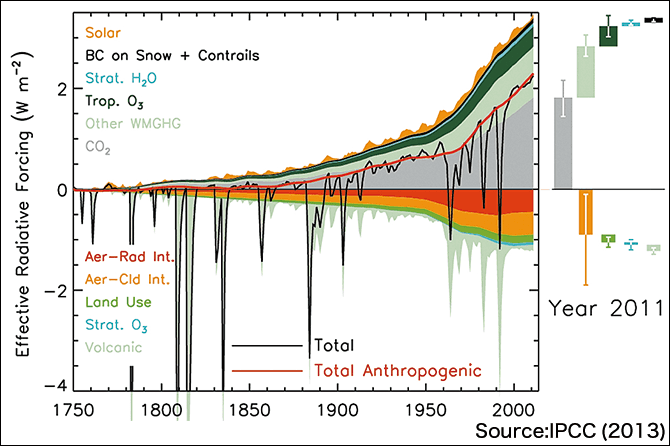We have come to frequently experience unprecedented scales of meteorological disasters such as typhoons, torrential rains, and heat waves. Climate variability, which had seemed to be a nonurgent issue, is now growing into an actual threat. Various data are pointing to global warming. How does the air temperature rise, and what is the current state of the earth? What should we be prepared for in facing this phenomenon?
Special Feature 1 – The Abyss of Global Warming Unpredictable dramatic changes –– What is now happening to the earth
composition by Rie Iizuka
In Japan, we have realized that summers have become hotter and winters have been milder. We are also experiencing more frequent meteorological disasters such as typhoons and torrential rains. The global surface air temperature has risen by about 0.8°C on average over the past 100 years or so, and we are experiencing an increasing number of instances that call to mind the term “global warming,” and moreover, “climate crisis.”
How does the air temperature rise? What kind of state is the present situation which is said to be in the midst of global warming?
The air temperature measured at 2m above the ground or sea level is called surface air temperature, and its global average value is used as an indicator of warming. The surface air temperature is independently measured by research institutions around the world including the National Aeronautics and Space Administration (NASA). The data for 1901 to 2012 show that the air temperature has risen overall, although there are short-term fluctuations. This change in the surface air temperature is not a trend limited to specific areas of the earth, but is virtually a global trend (Figure 1).

Figure 1. Changes in average air temperature from 1901 to 2012Values indicate the temperature change over the entire period. Areas lacking sufficient data are in white. It shows that the air temperature is rising on a global scale.
The earth is apparently warming
Then, why is the earth warming?
The earth’s surface is in a diverse state, ranging from deserts to forests, depending on air temperature and humidity. That state is maintained by solar radiation. As the amount of solar radiation differs by latitude, it creates temperature differences and causes flows in the atmosphere and ocean. Water and heat are constantly exchanged among the atmosphere, ocean, and land, causing complex interactions as a single climate system. Global warming is a phenomenon that occurs through the intertwining of elements in this climate system.
Let me explain one of the keywords of warming––“greenhouse effect.”
Simply put, surface air temperature is decided according to a simple law of physics called the law of conservation of energy, where incoming energy (solar radiation) is balanced with the energy emitted from the earth (planetary radiation). Disregarding the existence of the atmosphere, the earth’s surface temperature obtained by that law would be -18°C. However, as the actual earth has atmospheric layers that produces a greenhouse effect, the surface temperature is as much as 33°C higher than that, at about 15°C.
A few trace constituents (molecules) of the earth’s atmosphere absorb the planetary radiation emitted from the earth’s surface, and emit it back toward the earth, functioning like a blanket for the earth. This is what is called the greenhouse effect (Figure 2).

Figure 2. Schematic of greenhouse effectWithout greenhouse gases, the same amount of energy as the solar radiation reaching the land surface is emitted from the land surface. With greenhouse gases, a part of the radiant energy emitted from the land surface is absorbed by the atmospheric layers and returns to the land surface, so the air temperature becomes higher.
What are generally called greenhouse gases include carbon dioxide (CO2), water vapor, methane, chlorofluorocarbons, and nitrous oxide. Water vapor is in fact the most dominant greenhouse gas, but as its concentration changes considerably throughout the natural water cycle and its changes are affected more by changes in climate than by changes in human activity, we will treat it separately here. Greenhouse gases exist in trace amounts in the atmosphere, so they are expressed by the unit of parts per million (ppm) (1 ppm is 1/10,000 of 1%). Even so, as nitrogen and oxygen, which constitute most of the atmosphere, do not absorb radiation in their normal state, changes in the amounts of these trace gases cause unignorable changes in the amount of radiant energy the earth receives. After water vapor, CO2 exists in the largest amount among the greenhouse gases. Therefore, since the latter half of the 1980s when the issue of global warming began to be discussed, people began to focus on the relationship between the rise in the surface air temperature and the CO2 concentration in the atmosphere.
There was a researcher behind this trend.
Charles Keeling from the Scripps Institution of Oceanography in the United States started observation of CO2 concentrations at the summit of Mauna Loa on the Island of Hawaii in 1958. His initial purpose seems to have been to conduct research on urban air pollution. In this still-ongoing observation, the atmospheric CO2 concentration, which was 310 ppm at the start, exceeded 414 ppm in 2020. Since the CO2 concentration in around 1850, before the Industrial Revolution, is estimated at 285 ppm, the atmospheric CO2 concentration has been steadily increasing.

Figure 3. Atmospheric CO2 concentrations over the past 800,000 yearsTransition of atmospheric CO2 concentrations from 80,000 years ago to the present. The blue line denotes data obtained from South Pole glaciers and ice cores, and the red line denotes data for 1958 onward observed at the summit of Mauna Loa on the Island of Hawaii (source: Associate Professor Masakazu Yoshimori, The University of Tokyo). It shows that the rise in the CO2 concentration since the 20th century is at a level unprecedented over the past 800,000 years. (Obtained from the websites of the National Oceanic and Atmospheric Administration and the Scripps Institution of Oceanography)
Greenhouse gases increased dramatically
Carbon (C) circulates in nature by being absorbed in soil and water, erupting from the ground in volcanic activity, being taken in by land creatures, and so on. CO2 in the atmosphere had been kept at a concentration that achieves balance with other elements as part of the carbon cycle. Over the past 800,000 years of the earth’s history, the CO2 concentration has repeatedly increased and decreased along with the glacial-interglacial cycles, and we are currently at a time in the earth’s history when the CO2 concentration is high. Yet, the current CO2 concentration is apparently at an unprecedentedly high level in light of the past increase-decrease cycles and levels (Figure 3). This has been caused by changes in the natural carbon cycle as well as by human activity (emissions due to combustion of fossil fuels, such as oil and coal, and land use changes, such as deforestation).

Figure 4. Energy coming into and going out of the climate systemThe black solid line denotes the net radiant energy surplus, and the red solid line denotes that caused by human activity. Positive values indicate that the climate system is receiving excessive radiant energy.
Figure 4 is a graph showing actually measured or estimated radiant energy surplus in the climate system, i.e. the amount of energy that pushes up the air temperature. While estimation can be made for three centuries from 1750, yearly variations are noticeable before the Industrial Revolution, and we can see that, after the eruption of large volcanoes, the sulfuric acid gas contained in the smoke blocked the solar radiation, and cooled the earth. However, the amount of radiant energy surplus has been on a rise since the beginning of the 20th century, and in particular, the amount has soared (i.e., has warmed the earth) over the past 30 years. With regard to changes in the net energy received by the earth, the amounts measured by satellites coincide well with the amounts calculated by applying the values of changes in the atmospheric greenhouse gas concentrations to the formula of a theoretical radiation model. In other words, if the amounts of greenhouse gases increase, the earth’s surface will receive surplus energy, and it is possible to quite precisely calculate the global amount of radiant energy surplus for a specific year or the increase in the amount of energy surplus according to future variations in greenhouse gas concentrations.
The climate system amplifies warming
As mentioned earlier, the mechanism of the climate system is complex. If the CO2 in the atmosphere increases and the air temperature rises, various climatic elements change in response. This could further increase the radiant energy surplus, and accelerate the air temperature rise.
One example is water vapor. While water vapor has a greater greenhouse effect than CO2, as mentioned earlier, the amount of water vapor in the atmosphere increases roughly in proportion to the air temperature. Accordingly, if the air temperature rises as a result of a CO2 increase due to human activity, the amount of water vapor automatically increases and the greenhouse effect strengthens, leading to further warming. In the same way, if the air temperature rises and Arctic sea ice melts, the warming is amplified due to reduced reflection of solar radiation by sea ice. A warming simulation, which works out the complex climate system by using a computer model, projects that if the CO2 concentration doubles, the surface air temperature will rise by about 1.5-4.5°C. Of this increment, only about 1°C can be explained by CO2 alone, and the rest is the amount amplified by the complex action of the climate system. Such process called “feedback” is uncontrollable by humans, so the only thing we can do is to stop the rise in the CO2 concentration, which triggers this process.
The current warming simulation performs enormous calculations that incorporate all processes that can be mathematized, such as the motions of the atmosphere and ocean, the state of heat and water, and the state of energy and surface vegetation. The simulation can reproduce past climatic changes and changes in nature quite well, so it is believed to be correctly treating the basis of the climate system. However, as there are processes that we still do not understand and elements that have not been incorporated due to their uncertainties, it is feared that climate change that cannot be projected from simulation results could occur in the future.
One example is methane. The amount of methane is small compared to CO2 (about 1/100 of the amount of CO2 in the current atmosphere), but its greenhouse effect per unit amount is 25 times that of CO2. Methane is also a trace gas of which emission is increasing due to human activity, but a far larger amount of methane is trapped in the permanently frozen ground, or permafrost, in Siberia and Alaska. If the surface air temperature in polar regions rises and permafrost reaches the melting point, the methane gas will be rapidly discharged into the air at some point, and spur warming at once. Already, many craters formed by partial collapse of the permafrost have been found in these areas.
Meanwhile, phenomena associated with warming, such as the melting of sea ice and collapse of ice shelves protruding from the continent in polar regions, have an aspect of being irreversible. It is said that a once-collapsed ice shelf would not return to the original state for several hundreds of years even if warming was restrained. Such element of climate change that does not return to the original state if it crosses a certain threshold is called a “tipping element.” Many aspects about tipping elements still remain unknown, including when they might occur and what kinds of impact they might have.
So far, we have looked at warming of the entire globe, but it may be difficult to realize the impact of warming unless we narrow the spatial scale to Japan, or further, to the prefectural level. Indeed, the extent of warming is not the same throughout the world, and we cannot ignore the differences by latitude or region (Figure 1). In order to assess the impact of warming, it is essential to understand how the climate in the region has been originally.
Japan is an island country surrounded by sea, located at the east end of the Eurasian Continent. As the Kuroshio Current (or Black Current) brings a large amount of heat, the country has a milder climate than inland areas located at the same latitude. On the other hand, the surface air temperature in Japan has been rising more than 1.5 times faster than in the rest of the world since the 20th century. Its cause is unknown. Moreover, the warming simulation has predicted that the speed of the Kuroshio Current will become faster and that it will flow further to the north in the future, but the uncertainty is still too high to conclude that the prediction will hold.
Baiu (seasonal rain) is one of the phenomena that characterize Japan’s four seasons. It forms a part of the rainband called “monsoon,” which stretches over East Asia from China to South Korea. It is predicted that, if warming progresses, the monsoon rainfall will increase and the frequency of torrential rains will also increase in a wide area. However, we cannot say for certain how the beginning and end of the Baiu season will change, or how the position of the Baiu front will change.
It can certainly be said that warming will cause the air temperature in Japan to rise and make Japan’s summer hotter and winter warmer. However, future changes in the Kuroshio Current, Baiu, and the like are uncertain, because it is unknown how the future flows of the atmosphere and ocean will change, if at all.
Some people who take a negative stance against warming indicate that looking at the earth’s history of 4.6 billion years, climate has repeatedly undergone drastic changes, so a 1°C increase in the air temperature over the past 100 years is a slight matter. This indication is not necessarily incorrect. In the glacial-interglacial cycles over the past 800,000 years, the air temperature is said to have changed by nearly 10°C. The problem is that while the warming over the past 100 years may have been a small change for the earth, it is an unprecedented major change for human society after the Industrial Revolution.
A 1°C change in the air temperature greatly affects our lives
Our lives are greatly affected by 1-2°C changes in the average air temperature. It may seem that a “1°C change is not a big deal,” but the average air temperature in the summer of 2018, which marked record heat waves, was 1.7°C higher than the average year in East Japan. Such a major climatic change occurs when not the daily air temperature, but the average air temperature, rises. In addition, as society has developed industries adapted to the climate that differs by region, if the climate warms, the industries will need to be readapted. For example, if the warming progresses, farmers growing apples in Aomori Prefecture may have to switch to growing mandarin oranges (such shift has already started). Our current challenge is to correctly assess the impact of warming at the level of the region where we live, and to take appropriate action for maintaining a sustainable society.
The job of a climate scientist is to clarify the facts and the cause of the warming measured in the past and to derive a future prospect, not determining the good or bad of warming. However, as a result of examining the good things and bad things that could happen as a result of warming for all aspects related to humans, the consequence is that there are more bad things than good.




















